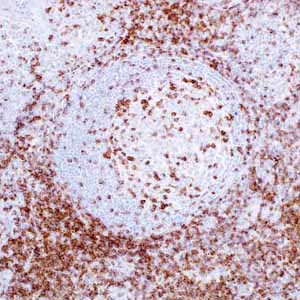
CD2 (MRQ-11)

Human T lymphocytes were initially distinguished from B lymphocytes by their ability to produce spontaneous rosettes with sheep red blood cells, a phenomenon mediated by the CD2 molecule, a glycosylated transmembrane receptor molecule also referred to as T11 antigen or LFA-3 antigen (leukocyte function associated antigen -3). Three functionally important epitope groups have been defined on the humans CD2 molecule, designated T111, T112, and T113, (CD2R). T111, is the epitope responsible for E-rosetting and T cell stimulation through this epitope and is mediated by an IL-2 dependent pathway (Meur et al, 1984; Knowles, 1984). Stimulation of the T112 and T113 epitopes occurs via an alternative pathway (Meur et al, 1984; Knowles, 1984). CD2 is one of the earliest T cell lineage restricted antigens to appear during T cell differentiation and only a rare CD2+ cell can be found in the bone marrow. It is found in all T-lymphocytes and natural killer cells but not in B cells or any other cell population. CD2 binds to its counter receptor CD-58 (LFA-3), a member of the Ig gene superfamily, which located on the surface of target cells. CD2 binding to LFA-3 activates T cells and may also have a role in prothymocyte homing as it is known to mediate thymocyte-thymic epithelium adhesion. Although it is known that CD2 appears after CD7 but before CD1, its temporal relationship with CD3 is less definite, with some recent evidence suggesting that CD3 appears in the cytoplasm before CD2 (Osborn et al, 1995). CD2 can be considered a pan-T cell antigen and is therefore useful for the identification of virtually all normal T lymphocytes. It is also very useful in the assessment of lymphoid malignancies as it is expressed in the majority of precursor and post-thymic lymphomas and leukemias and is not expressed by B neoplasms (Foon & Todd, 1986). As with other pan-T cell antigens, CD2 may be aberrantly deleted in some neoplastic T cell population, especially peripheral T cell lymphomas. Rarely slg+ B cell neoplasms have been described to form spontaneous E-rosettes but these reactions are not mediated via the CD2 receptor (Knowles, 1989).
